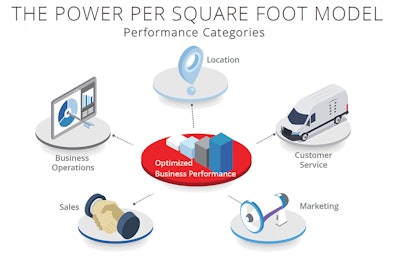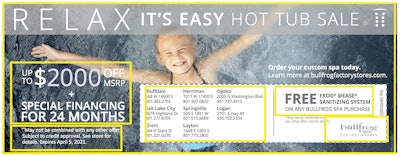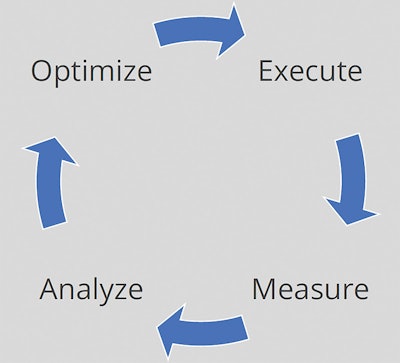
Advertising serves a critical purpose for pool and spa retailers, not just to effectively compete within the hot tub market, but to catch the attention of potential buyers. At the International Pool | Spa | Patio Expo in Dallas, Texas, Jake Ricks, director of marketing at Bullfrog Spas, offered up valuable insights into how dealers can develop a successful ad marketing strategy.
“We feel that by sharing success in advertising,” he says, “it benefits the whole hot tub category. I want to grow spa markets and if any dealer, even a dealer that sells a competing product line, is advertising, well, it’s beneficial for us. When we grow the market to a good size, everyone can spend less money on advertising, and their advertising gets more efficient.”
With that in mind, we followed up with Ricks after the seminar to review some of the key takeaways from his presentation. This advertising model, designed by Bullfrog Spas, is called Power Per Square Foot.
 This image depicts the Power Per Square Foot method developed by Bullfrog Spas.Photo courtesy Jake Ricks, Bullfrog Spas
This image depicts the Power Per Square Foot method developed by Bullfrog Spas.Photo courtesy Jake Ricks, Bullfrog SpasThe model calls for five key components to an optimized business performance: location, customer service, marketing, sales and business operations.
There are a few ways to grow your market: One would be to capture more of the existing market share, and the second is to grow your overall market and increase the total size of the market. “We greatly prefer that second approach for a number of reasons,” says Ricks. “Growing the spa market in your area is a better long-term strategy than chasing limited market share. And how do you grow the spa market? With advertising.”
First, budget. An ideal advertising budget for local spa dealers starts with a percentage of what they intend to sell. “If you just want to maintain, you should spend 5 or 6% of revenue ad spend,” explains Ricks. “If you want to grow, you are going to be somewhere around 10% of revenue ad spend. When you spend 20 to 25%, you’re going to have more explosive growth, but it’s also more expensive and risky.”

A successful ad campaign involves three critical components:
- The right ad calendar
- The right ad channels
- The right kind of ads
“The question then becomes, ‘What are you advertising?’” says Ricks. “Bullfrog Spas bases its ad calendar around two reasons to advertise: in-store sales and offsite events.”
In-store sales — dealers should always be in a current promotion, be moving into an upcoming promotion, or be coming out of a promotion — are important to establish store locations and as much general awareness in the local market as possible. Eight to 10 promotional periods, scheduled around the holidays and seasons, is an ideal ad calendar.
“There are a lot of people that prefer not to have sales, ever, and not to do any discounting or anything like that, but we’ve really felt that in a category like hot tubs, where price is always going to be an objection, that some reason to buy today, that creates some urgency, is always going to be beneficial,” says Ricks.
Offsite events are important because “to serve any market well, you need more locations than is usually economically feasible for most dealers,” says Ricks. “We pick locations within the greater market where we can go do offsite events and serve those parts of the market better. For spa dealers, these can be parking lot events, home shows and fairs, for example.” The next critical component, ad channels, is directed to:
- Broadcast — to cast a wide net over your market (radio, television, OTT video)
- Targeted touches — messages to the right geographies and demographics (direct mail, coupon circulars, social media)
- Search ads — to harvest interest (Google, Bing)
Bullfrog Spas has found success in directing its advertising budget to be 60% broadcast ads, 20% targeted ads and 20% search ads. When advertising across any platform, Ricks advises the right kind of ad should contain:
- A clear and consistent logo and brand/company identifier.
- A unique value proposition statement (include a clear tie breaker).
- An urgency date, such as “Sale Ends Saturday!” or “While supplies last!”
- Locator information, or how potential buyers can find your store or contact you.
Below is an example of a successful ad, courtesy of Bullfrog Spas. The indicators above are boxed in yellow. Ricks highly recommends that spa dealers use a professional to design ads.
 Photo courtesy Jake Ricks, Bullfrog Spas
Photo courtesy Jake Ricks, Bullfrog SpasWhen creating a successful radio ad, the requirements look a little different. It’s first important to refrain from a “yell-and-sell” approach. “We feel that does our industry a disservice,” says Ricks. “We almost always take a friendly, authoritative tone in our radio ads. What this means is, whether it’s a salesperson or someone from our business, we want them to feel friendly and approachable, but also authoritative about the category. Not many listeners know much about the hot tub category, so you have to build trust really quickly.”
Radio, given it does not have a visual logo or brand identifier, has different tags, but should still have very clear branding. “Sometimes, we just mention locations,” says Ricks. “We feel that’s most effective because people can start to envision how they’re going to end up at your store. Secondly, we might offer a website that people can look up.
“And when selecting radio stations, prioritize active listening — talk news or sports are kind of the holy grail. It’s also important to prioritize frequency over reach. We try to get people to hear the radio ad more often, rather than getting it out to the widest possible audience and at a low frequency.”
Targeted ads allow spa dealers to get a little more dialed in on demographics and geographies. They can be targeted digital posts, like Instagram or Facebook. They can also be direct mail, such as coupon circulars. “And then search ads are like the trigger,” says Ricks. “A lot of the time, you get a little attention with broadcast, and you might enhance that interest with a bit of targeted touch, but search is where potential buyers go next. They’re going to search, “hot tubs near me,” and you have to be there. That’s the last touch.”
How do you know your advertising is working?
A very simple return on ad spend (ROAS) formula measures the amount of revenue earned for every dollar spent on advertising. This formula, shown below, if tracked correctly, can greatly improve where you place your advertising dollars. It’s a pretty basic metric: Total all of your ad spend and divide it by what you sold in that period, and that is your ROAS.

“If dealers are religious about doing calculations for each promotion, for every single offsite event,” says Ricks, “pretty soon, you’re going to get much better at ad design and determining successful, offsite locations.”
Over a long period of time — it takes a few years of running the same sale and offsite event to collect reliable data — you can start to optimize your spending, which can place you in an optimization cycle.
 Photo courtesy Jake Ricks, Bullfrog Spas
Photo courtesy Jake Ricks, Bullfrog Spas“It’s important for dealers to develop a mindset that this is a marathon and not a sprint. You’re going to be doing this for a very long time, and you’re not going to be perfect at it at first, but you’re going to continue to get better as you go,” says Ricks. “And your ad spend will get more efficient. Your market size will start to grow at the same time. And then it gives you a lot of confidence to put a lot more money into your ad program, and you can start a reliable plan for growth.
“In your second year, you’re going to get some data. In your third year, you’re going to get lots more, and then years four, five, six, seven — we’ve been doing it for longer than that at this point — you really start to get pretty dialed in. You start to predictably know, if I spend X, I’m going to sell Y. And that’s when it gets really, really exciting.”
This article first appeared in the February 2022 issue of AQUA Magazine — the top resource for retailers, builders and service pros in the pool and spa industry. Subscriptions to the print magazine are free to all industry professionals. Click here to subscribe.












































